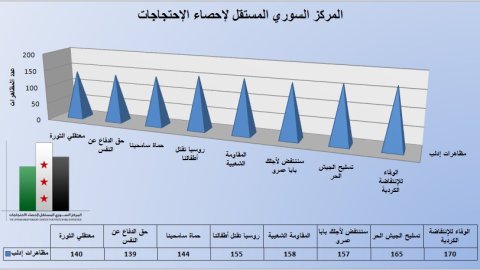Despite the destruction, and the ominous retreat of the nonviolent movement in the face of militarization, the Independent Syrian Center for Protests Statistics (ISCPS) has maintained its weekly mission of documenting, through hard numbers, the protest movement in Syria.
Providing data of the weekly protests
The idea for the center started with the very beginning of the uprising. In the first few months, most Syrians found themselves faced with a confusing scene of contradictory rumors, and an avalanche of Youtube videos of protests they could not verify, from places they had not heard of before. The need was keenly felt for independent centers of statistics that could offer reliable reports and information to the public.
Most of the young men and women who founded the ISCPS had no prior academic or practical experience with such work. According to one founding member, “the team started as cooperation between individuals who were working on the same issue: attempting to provide clear numbers of the weekly Friday protests around the country.” After the exponential growth of the protest movement, the group felt it was important to unite their efforts under a single umbrella organization.

The center was officially established on January 20, 2012. From early on, the center garnered significant attention and faced a great demand for reliable data. This growth convinced the center members of the need to actively preserve their independence, and thus their credibility. A decision was made to “keep ourselves independent from any political currents or coalitions in formation at that moment in the revolution,” explains one of the members. “Despite our different backgrounds and political outlooks, we were able to preserve our internal cohesion and independence, and that was one of our main achievements,” he adds.
Innovation within an increasingly difficult context
Nevertheless, in its first month, the center was rocked by the arrest of its founder for a year. According to one member, “at first we did feel a bit lost with him, but we got over it soon after, and continued our work based on the vision we had developed together.” In that period the center increased its outreach efforts, through new designs, a new Facebook page and releasing their data in English. New visualization methods were introduced as well including charts, mapping and progressive visualization techniques that allowed the center to study the progress of the protest movement. The latter, according to one member, “helped us get to understand in depth the various localities around the country and introduced us to many new towns and villages we had never heard of before.”
One of the main innovations of the center was the use of Google Maps along with interactive data layers that show demonstrations in real-time. This allowed the center to crowdsource and manage information on protests, without sacrificing its reliability. In this model, the citizen and the activist become active participants in the documentation of their protest, and thus the center’s community grows exponentially to include many of the youth activists in the local coordination committees around the country. These individuals perpetuated the work of the center and helped their efforts by sharing photos and videos of the demonstrations, as well as providing a needed critique of their work.

The center also introduced comparative statistics to provide researchers with complete datasets of different days and allow for in-depth analysis of the differences from one week to another.
The main difficulty facing the center is the heavy workload associated with such effort especially the tasks of verification, investigation, management and ensuring the integrity of the data. This is also compounded by the fact that most members of the center are volunteers. The center has received several offers for funding, however, “after consultations within the team we would always reach the same conclusion: we can not accept any form of material support if we are to truly guarantee the independence of the center and the credibility of our work.”



